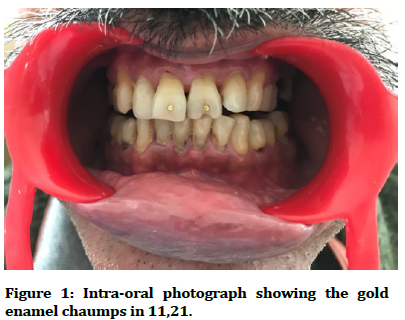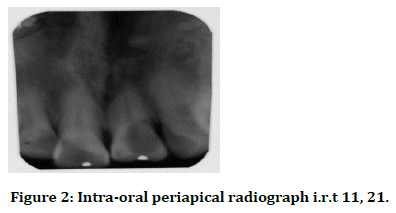Case Report - (2021) Volume 9, Issue 9
Cultural Symbolism Adorned on Enamel as Gold Choumps: A Case Report
Ramya R Iyer1* and Faisal Sheikh2
*Correspondence: Ramya R Iyer, Iyer Department of Public Health Dentistry, KM Shah Dental College & Hospital, Sumandeep Vidyapeeth (An Institution Deemed to be University), India, Email:
Abstract
Gold enamel choumps are intentional dental modifications of cultural significance, observed among certain tribal communities of India. The present case report is an illustration of this unique adornment practice in the Bhilala tribe of Madhya Pradesh. Gold tattoo or engravings on maxillary anterior teeth in this community, marks the onset of puberty among males and wearing those, is believed to invoke good fortune. This is the first reported case of enamel choumps in the Bhilala tribal community.
Keywords
Intentional dental modification, Enamel tattoo, Tribal community
Introduction
Dental anthropology refers to the study of morphology & odontometrics, palaeontology, genetics & evolutionary pattern, cultural influence on natural and inflicted modifications in teeth, relevant to health, pathology and forensic science. Bio-cultural anthropology is a discipline of anthropology which studies human behaviours using both biological and cultural data. Dental bio-culturalism relies on decoding the cultural imprints on teeth and its surrounding structures and unravelling the various cultural beliefs behind the dental practices and behaviours of community [1].
Intentional dental modifications have been studied in various communities and have helped in understanding dental practices from bio-cultural perspective. Some of the dental modifications have been attributed to occupation, as evidenced as symmetrical notches in anterior teeth of crania from archaeological sites in Tennessee [2] and among Australian aborigines [3], owing to gripping of tools and flaking of tools respectively.
However, some of the intentional dental modifications on anterior teeth are signatures of esthetic and decorative perceptions held by a community. Anterior gold basket crowns are a type of restoration worn among remote Amazonian communities, primarily placed for cosmetic and social reasons [4]. Intentional modifications on anterior teeth may as well as symbolize values of valor, virginity or mark tribal identity, developmental milestones and social status [5-6].
Identification and knowledge of culturally influenced tooth modification are important not only to reconstruct the past life- styles but also prompts us to look through the spectacle of ethnic identity and cultural acceptability, whenever dental advice, procedure or an individual/ community–based intervention is planned or rendered.
Case Report
A 45 -year old male individual, named, reported to the Department of Public Health Dentistry, KM Shah Dental College, Sumandeep Vidyapeeth, Vadodara, India, for routine dental check- up.
He was a native of Dhar district of Madhya Pradesh and a farmer by occupation. He had reportedly come to Vadodara to accompany one of his relatives who had to get admitted for a chronic medical condition at the medical hospital facility located in the same campus.
The subject was asymptomatic and did not self- report any intended purpose of visit or any oral health condition that bothered him.
On intra-oral examination, small round shaped, gold stampings or engravings, approximately 1.5 mm diameter were found embossed at 3mm from the incisal edges of 11 and 21 (Figure 1).
Figure 1. Intra-oral photograph showing the gold enamel chaumps in 11,21.
When inquired regarding the gold engravings, the subject reported that his parents got the adornments done on his teeth by a traditional skilled expert, as a cultural practice as they believed that it would bring good omen, financial growth and stability in the individual. He said that he got them done when he was in his early teenage and told that boys in his community adorn these as a mark of puberty. He described that the traditional expert performed the procedure with wood and metal instruments and no anaesthesia was used. He described that he did not remember whether the procedure was eventful or not; however, he stated that he presently did not experience any pain, discomfort or in masticatory problems because of the adornments.
The incisal edge of 21 showed notching at the mid-line, which could have been due to the excessive and improper methods employed during the procedure; however, the patient did not remember the reason for the notched enamel. 21 showed mild blackish intrinsic tooth discoloration, with no evidence of undermined caries. Tenderness on percussion and mobility were negative i.r.t 12, 11, 21 and 22. Other significant findings in intra-oral examination were -chronic generalized periodontitis and generalized abrasion.
A clinical diagnosis of Gold Enamel Choumps i.r.t 11 and 21 was made based on the history and oral examination.
On electric pulp testing, 11 and 21 were found to be vital. Intra-oral periapical radiograph showed apical one-third root resorption (external root resorption) i.r.t 21 and mild periapical radio-opacity ir.t 11, with traceable patent root canals (Figure 2).
Figure 2: Intra-oral periapical radiograph i.r.t 11, 21.
Discussion
In the present case, the subject belonged to Bhilala tribe, which is an aboriginal community, native to Madhya Pradesh and Gujarat states of India. They are densely populated in Dhar, Jhabua and West Nimar districts of Madhya Pradesh. It is believed that Bhilala are superstitious and believe that evil eye can cast bad spells on a person; hence their rituals and cultural practices are influenced by their beliefs to cast out the effects of evil eye. In olden days, it is believed that they even had witch doctors to heal diseases. With changing times, it can be inferred that many of such primitive practices and beliefs have largely got diminished, yet leaving residual cultural practices that have lived through the tests of time. The Bhilala community even today are known for their love for food, art, jewellery and colourful clothing. Most of them wear tattoos [7].
Cultural practices glorify beliefs held by the community. The present case is an illustration of one such practice – gold enamel tattoos/adornments on tooth enamel with gold to symbolize welcoming of puberty. In certain other tribes as well, choumps are engraved on teeth to mark the entry to adulthood [8].
In a case report by Yadav et al [9], two individuals from rural parts of Jaipur, of ages 39 years and 51 years, had presented with enamel choumps similar to that in the present case. However, in their report, both the subjects were females, who had expressed that enamel tattooing was done to beautify their teeth and that it was a family custom. This shows that both the genders had enamel tattooing done, however reasons were different.
Kotecha et al [10] reported a case of enamel choumps in a 11- year old boy, belonging to Gujjar tribe of Uttar Pradesh, India, with similar clinical presentation. However, no periapical changes were observed in their case. This could be due to the young age of the patient and short period of observation from the time of adornment.
In a case reported by Hans et al [11], three enamel choumps were worn by a 22- year old patient on maxillary central incisors and one spot gold choumps were observed on maxillary lateral incisors. This shows that there could be variation in patterns of choumps among different tribes; this view has also been supported by Anand Kumar et al [12].
The subject in this case described that crude tools were used to drill and place the gold choumps in the enamel and no anesthesia was administered prior to the process. Similar practices have been reported in the literature by Hans MK et al [11] and Suhas et al [13].
In the present case, the subject was not referred for management of 21 with apical third external root resorption as there is no evidence to justify endodontic procedure in teeth with external root resorption, when pulp is vital [14]. Furthermore, the subject was asymptomatic through-out and the cause for the external root resorption can only be inferred on a presumptive basis, in the context of this case.
The present case is of importance as incidence of enamel choumps is very less and can serve as ethnic identification mark [13]. This is the first reported case of enamel choumps in Bhilala tribal community. Furthermore, gold enamel- tattooing is in itself, a distinct practice among culturally- rich, native tribal communities of India, which include the Bhilala tribes, Gujjar tribes, some Jaduvanshi Thakurs and Jaat tribes.
The case report also opens the debate on whether it is ethnically correct or not to tackle this potentially deleterious dental modification and inform to the community regarding risks of this mutilation practice. However shiny the gold might be on surface, it is important from a dental public health perspective, to prevent aseptic and unsafe procedures involved in the process of its adornment.
References
- https://trace.tennessee.edu/utk_gradthes/3240
- Blakely RL, Beck LA. Tooth-tool use versus dental mutilation: A case study from the prehistoric Southeast. Midcontinental J Archaeol 1984; 9:269-284.
- Gould RA, Koster DA, Sontz AHL. The lithic assemblage of the western desert Aborigines of Australia. Am Antiquity 1971; 36:149-169.
- Jamil F. The use of anterior gold basket crowns among remote Amazonian communities. Brit Dent J 2014; 216:475-476.
- Whittlesey HG. History and development of dentistry in Mexico. J Am Dent Assoc 1935; 22:989-995.
- van Reenen JF. Tooth mutilation amongst the peoples of Kavango and Bushman land, South West Africa (Namibia). J Dent Assoc South Africa 1938; 33:205-218.
- http : / / kcm . co . kr / bethany _ eng /p_code1/586.html
- Singh B, Nanda T, Ohri T, et al. Enamel choumps: Case report and short review. Int J Dent Health Sci 2017; 4:24-927.
- Yadav R, Yadav A, Rai R, et al. Gold tooth tattoos: Identifying features in forensic odontology. J Clin Diagnostic Res 2016; 10:8-9.
- Kotecha SD, Hedge DY, Chaudhry K, et al. Gold enamel choumps- a case report. Egyptian J Forensic Sci 2016; 6:303–306.
- Hans MK, Nagpal A, Shetty S. Choumps. Brit Dent J 2011; 211:194.
- Anand Kumar C, Sawhney H. ‘Choumps’ enamel tattoos revisited -case report. J Forensic Odontostomatol 2009; 27:81-86.
- Suhas S, Anand Kumar C. ‘Choump’ enamel tattoos. J Forensic Odontostomatol 2007; 25:61-62.
- Consolaro A, Bittencourt G. Why not to treat the tooth canal to solve external root resorptions? Here are the principles! Dental Press J Orthod 2016; 21:20-25.
Author Info
Ramya R Iyer1* and Faisal Sheikh2
1Iyer Department of Public Health Dentistry, KM Shah Dental College & Hospital, Sumandeep Vidyapeeth (An Institution Deemed to be University), India2Chief Dental Surgeon (Private Practice), Muslim Medical Center, Vadodara, India
Citation: Ramya R Iyer, Faisal Sheikh,Cultural Symbolism Adorned on Enamel as Gold Choumps: A Case Report, J Res Med Dent Sci, 2021, 9(9): 80-82
Received: 25-Jun-2021 Accepted: 07-Sep-2021


